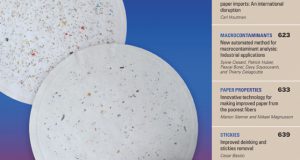The papers summarized here are from the September and October 2017 issues of TAPPI Journal. TAPPI Journal is an online publication of relevant and timely peer-reviewed research delivered via email and free to all TAPPI members. To receive TAPPI Journal, join TAPPI at www.tappi.org.
SEPTEMBER
PAPERMAKING
Three-dimensional pore structure visualization and characterization of paper using x-ray computed tomography
Yves Defrenne, Vasili Zhdankin, Sahana Ramanna,
Shri Ramaswamy, and Bandaru V. Ramarao
Porous biomaterials such as paper and board have a complex structure that influences their mechanical, optical, and transport properties and thereby their performance during manufacturing and end uses. Reconstruction of the three-dimensional (3D) pore spaces in paper was obtained by X-ray computed tomography and used to study the structure and its impact on properties. A set of laboratory-made paper samples of varying freeness was prepared, and the 3D structures of the samples were visualized and characterized. Tomographic reconstruction images were processed using techniques such as anisotropic diffusion, minimum error thresholding, and isolated voxel removal to enhance image quality.
The pore structures were analyzed to determine porosity, fiber-pore interfacial surface area, geometric tortuosity, and pore size distributions (using a sphere growing algorithm). These properties were compared with experimental data and were found to be in good agreement. Researchers then compared results from 3D visualization and characterization with experimental data of various samples using conventional pore structure characterization techniques, such as mercury intrusion porosimetry.
This study showed how image processing techniques can help mills better understand the complex structure of porous biomaterials that influences properties and performance of manufactured products.
NONWOVENS
Oil absorption and desorption by polypropylene fibers
Praveen Kumar Yegya Raman,
Akshay Jain, and Seshadri Ramkumar
Oil spill is a threat to the ecosystem, and there is a need to develop highly efficient oil sorbents for environmental remediation. In this study, researchers evaluated four different types of polypropylene fibers for their oil absorbency and desorption characteristics. These fibers varied in their fineness and structural characteristics, i.e., hollow or solid. The study used a modified ASTM methodology to better represent the oil sorption capacity of a sorbent.
To the best of our knowledge, this is the first study to present the effect of fiber fineness and structure on the oil desorption behavior of polypropylene fibers. Results showed that finer fibers had higher oil sorption capacity (g/g) than the coarser fibers. There was no statistical difference in the rate of desorption among the solid fibers; however, the hollow fiber had a statistically higher rate of desorption than the solid fibers.
This study will help with the development of efficient sorbents that will have high oil sorption capacity and ease of transportation.
BIOREFINERY
Addition of corn stover arabinoxylan into hardwood during pulping for improved physical properties
Anurag Mandalika and Troy M. Runge
Agricultural residues such as corn stover are being considered for biofuels and bioproducts. They represent inexpensive, pentosan-rich feedstocks that are abundantly available. These materials are typically pretreated to make them more amenable to biological processes such as fermentation. One such treatment involves extraction using alkali to remove the hemicellulose, leaving the cellulose more accessible for chemical or enzymatic hydrolysis. Extracted xylan hemicellulose may be considered for use in pulp and paper, or for providing a potential value stream from cellulosic ethanol biorefineries. To be useful, the extracted xylan should be concentrated and adsorbed into the pulp using existing equipment or a minimal number of new unit operations.
In this work, we explored the concept of size-exclusion membrane-filtration to concentrate xylan that was extracted from corn stover in mild alkaline conditions. We examined hollow-fiber and tangential-flow filtration types and achieved a nearly two-fold increase in the xylan concentration using the former with a 50 kDa molecular weight cut-off (MWCO) membrane. Cassette-type tangential-flow filtration resulted in slightly greater xylan concentration with the use of a 10 kDa MWCO membrane. Hemicellulose extracts were then used as an additive during kraft pulping of hybrid poplar to show that the xylan could be adsorbed onto pulp fibers and retained even after washing.
Pulp tensile strength improved after xylan addition following refining. An average of 33 percent of the xylan added in this method was retained, with xylan loading between 5 wt% and 20 wt%, compared with the control pulp sample that did not have added xylan. These results suggest potential for further exploration of biorefinery extracts use as additive feedstock for pulping. The study, being an evaluation of the proof-of-concept, aims to push research and optimization in this area that will lend well to scale-up and commercialization.
This work benefits mills in demonstrating that adjunct hemicelluloses may be incorporated into their pulp products, and if obtained from a low-cost source, could provide an increase in sellable pulp mass. This work also underlines the importance of hemicellulose content on pulp properties.
OCTOBER
RECOVERY CYCLE
Formation mechanisms of “ jellyroll” smelt in kraft recovery boilers
Honghi Tran and Andrew K. Jones
Molten smelt normally flows smoothly down the smelt spout of a recovery boiler like water, but at times it suddenly becomes sluggish and forms a viscous blob on the spout trough that partially or completely blocks the smelt flow. This form of smelt is commonly referred to as “jellyroll” smelt. How such smelt forms has been a puzzle to boiler operators and mill personnel for years.
Numerous mill observations and the results of a recent study performed on both smoothly flowing smelt and jellyroll smelt collected from a recovery boiler suggest that that jellyroll smelt can form through three main mechanisms: i) the freezing of the molten smelt, ii) the melting of fallen deposits, and iii) the inclusion of a large amount of unburned char in the molten smelt. These mechanisms are consistent with mill experience that jellyroll smelt tends to form in older recovery boilers burning liquor with low solids and low sulfidity.
This paper discusses the three mechanisms through which jellyroll smelt forms and provides operating strategies for minimizing jellyroll smelt formation.
PAPERMAKING
Effect of conductivity on paper and board machine performance—a review and new experiences
Lebo Xu, Przemyslaw E. Pruszynski, and Peter W. Hart
The current trend to further reuse water within paper mills has resulted in more accumulated salts, as reflected by increased conductivity values. Although conductivity measurement is widely used in paper mills, its fundamental principles and interpretation are not often fully understood. This keeps papermakers from reaching the full benefits of using conductivity measurements to help manage the wet end chemistry of paper or board machines. High and variable conductivity affects the intrinsic properties of pulps, the performance of chemical additives, and the interaction between them.
This research reviews principles of conductivity; its measurement; its effect on important aspects of papermaking operations, such as retention, drainage, sizing, strength development, and deposit control; and the fundamentals behind the effects of conductivity on the papermaking process. Specific mill examples are also provided. Potential solutions for operating a mill under high and variable conductivity conditions are discussed.
Understanding the principles of conductivity measurement and its limitations can help mills interpret the effect of high ion concentration on the papermaking processes. It will also help papermakers gain insight into issues associated with increased and changing conductivity for troubleshooting.
WASTEWATER TREATMENT
Degradation of 2,4-dichlorophenol by melamine amine cellulose-immobilized lacasses
Zhen Wang, Pingping Bin, Ying Liu,
Yu Liu, Guihua Yang, and Lucian
Epoxidized dialdehyde cellulose (EDC) was prepared and grafted with melamine to obtain melamine grafted epoxidized dialdehyde cellulose (EDC-melamine); the products were characterized by various methods and were used as carriers to immobilize laccase.
Results show EDC-melamine can immobilize laccase effectively and have higher enzymatic activity compared with EDC. Furthermore, the enzymatic activity of EDC-melamine was found to be as high as 865 U•mg-1, compared with 140U•mg-1 for EDC. The removal efficiency of 2,4-dichlorophenol (2,4-DCP) for EDC-melamine immobilized laccase was about 71.5% at 40°C for 4 h at 10.0 mg•L-1 and dosage of laccase = 0.2 g/L. The removal efficiency can remain greater than 63%, even after six cycles.
This topic provides a new method to immobilize laccases. The product can be used to treat wastewater polluted by phenol and shows excellent performance.
A 3D characterization of the pore size distribution was achieved using a sphere-growing algorithm. (Cross section of the processed image before (l) and after (r) fitting spheres.)
For the oil sorption study, researchers used a modified ASTM F726-12 test with non-detergent motor oil and polypropylene fibers.
Handsheet results displayed a marked strength improvement for the arabinoxylans-modified pulp, primarily for low refining levels.
Appearance of fluid and jellyroll smelt samples (pink parts are smelt; black parts are char) after being cooled to room temperature.
Effect of conductivity on dosage of alkyl ketene dimer (AKD).
SEM images of
(A) microcrystalline cellulose and
(B) EDC-melamine show that the surface of cellulose changed significantly before and afer modification.
Other research appearing in TAPPI Journal’s September 2017 issue:
RECYCLING
Effect of surface treatment with biodegradable materials on properties of linerboard made from old corrugated containers (OCC)
Somayeh Heydari, Ahmad Reza Saraeyan
and Alireza Shakeri
Other research appearing in TAPPI Journal’s October 2017 issue:
BLEACHING
Techno-economic analysis of ECF bleaching and TCF bleaching for a bleached eucalyptus kraft pulp mill
Tiago de Assis, Jordan Perrin, Hasan Jameel, Richard Phillips, Dominique Lachenal, Adrianna Kirkman, and Ronalds Gonzalez
 Paper 360
Paper 360


